Strategies of Red Bull Company in UAE
VerifiedAdded on 2022/08/12
|13
|3683
|25
AI Summary
The requirements are attached. A brief Intro is needed, conclusion as well and most importantly an executive summary. At least 10 peer reviewed articles or citations
Contribute Materials
Your contribution can guide someone’s learning journey. Share your
documents today.
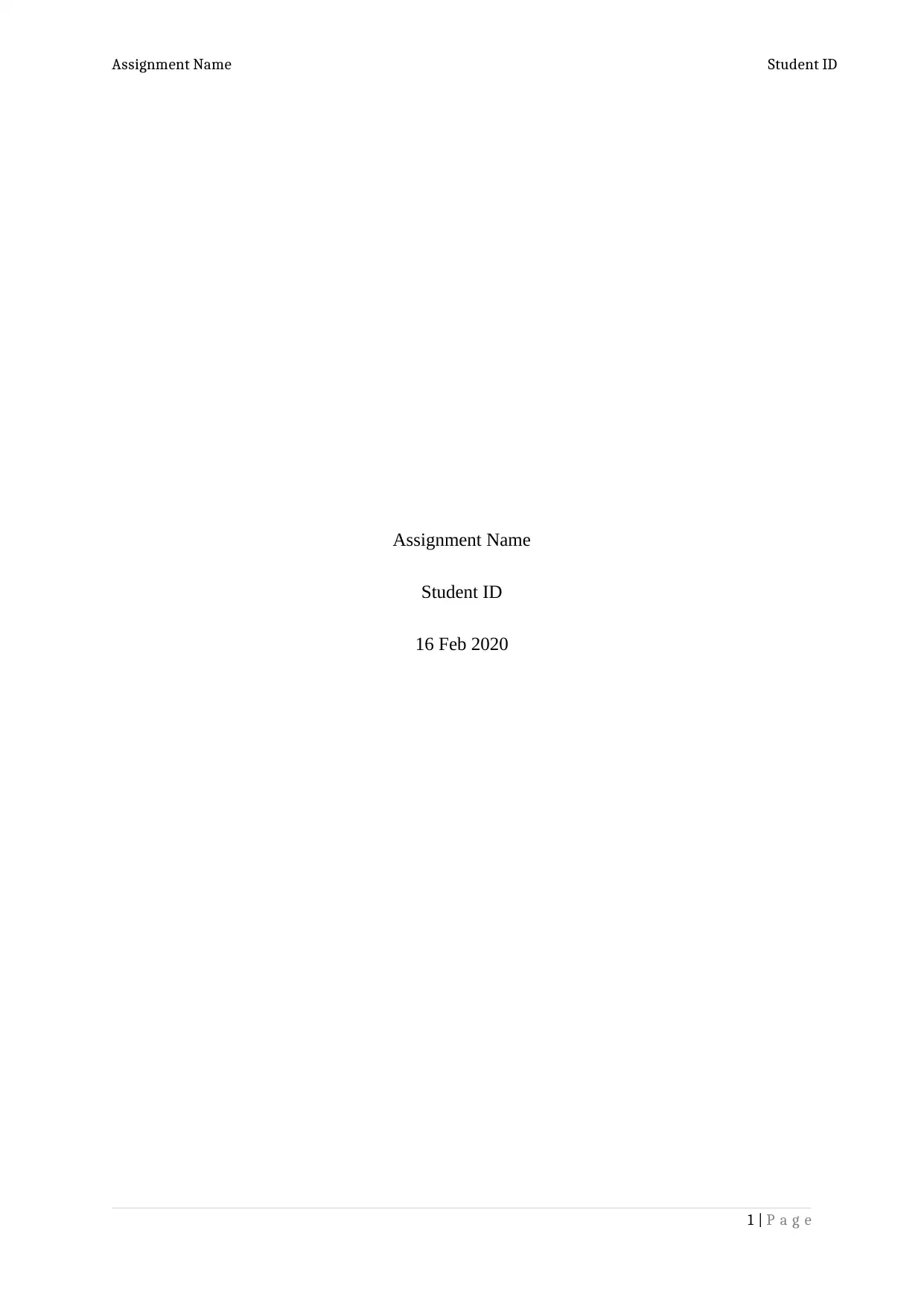
Assignment Name Student ID
Assignment Name
Student ID
16 Feb 2020
1 | P a g e
Assignment Name
Student ID
16 Feb 2020
1 | P a g e
Secure Best Marks with AI Grader
Need help grading? Try our AI Grader for instant feedback on your assignments.
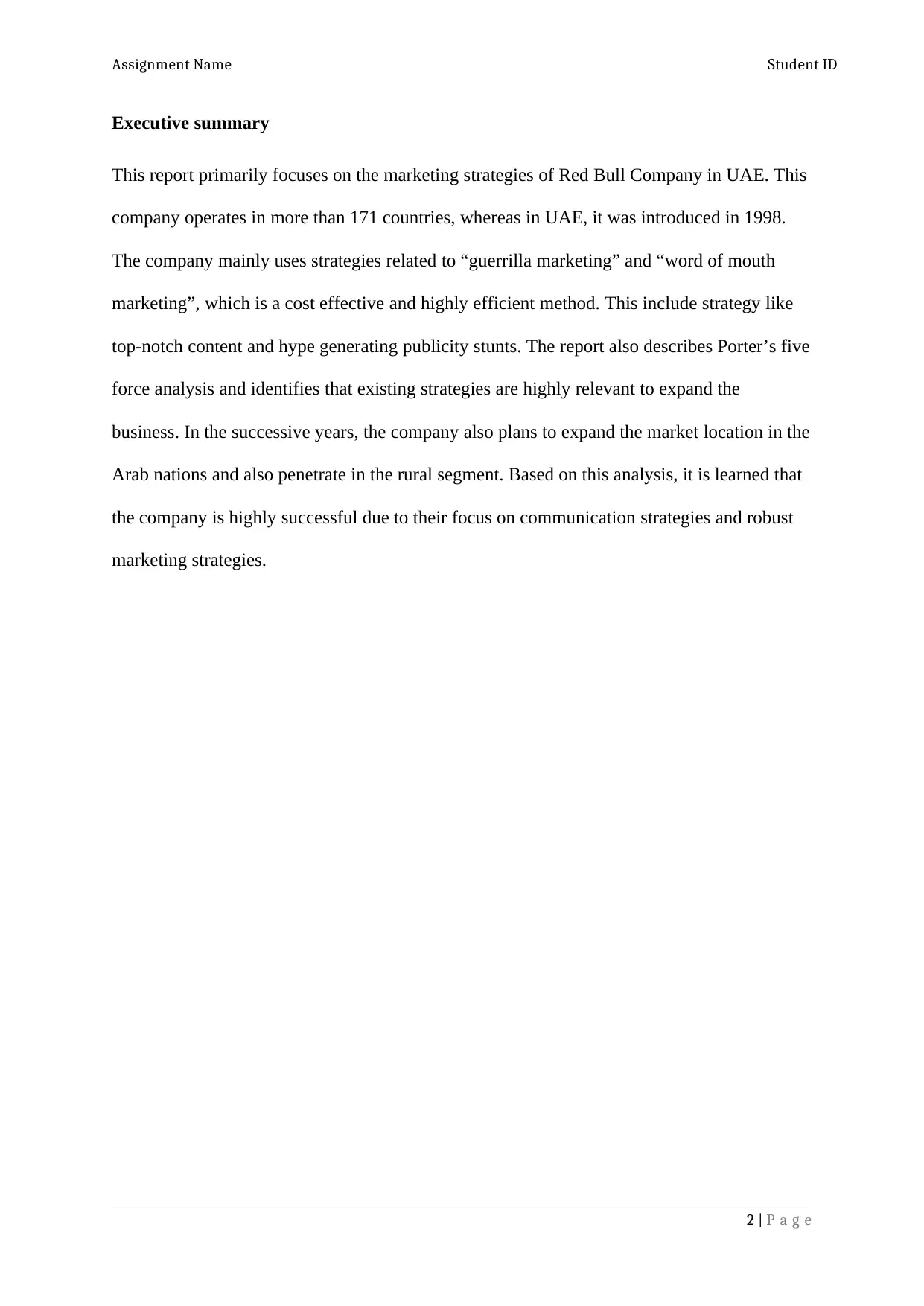
Assignment Name Student ID
Executive summary
This report primarily focuses on the marketing strategies of Red Bull Company in UAE. This
company operates in more than 171 countries, whereas in UAE, it was introduced in 1998.
The company mainly uses strategies related to “guerrilla marketing” and “word of mouth
marketing”, which is a cost effective and highly efficient method. This include strategy like
top-notch content and hype generating publicity stunts. The report also describes Porter’s five
force analysis and identifies that existing strategies are highly relevant to expand the
business. In the successive years, the company also plans to expand the market location in the
Arab nations and also penetrate in the rural segment. Based on this analysis, it is learned that
the company is highly successful due to their focus on communication strategies and robust
marketing strategies.
2 | P a g e
Executive summary
This report primarily focuses on the marketing strategies of Red Bull Company in UAE. This
company operates in more than 171 countries, whereas in UAE, it was introduced in 1998.
The company mainly uses strategies related to “guerrilla marketing” and “word of mouth
marketing”, which is a cost effective and highly efficient method. This include strategy like
top-notch content and hype generating publicity stunts. The report also describes Porter’s five
force analysis and identifies that existing strategies are highly relevant to expand the
business. In the successive years, the company also plans to expand the market location in the
Arab nations and also penetrate in the rural segment. Based on this analysis, it is learned that
the company is highly successful due to their focus on communication strategies and robust
marketing strategies.
2 | P a g e
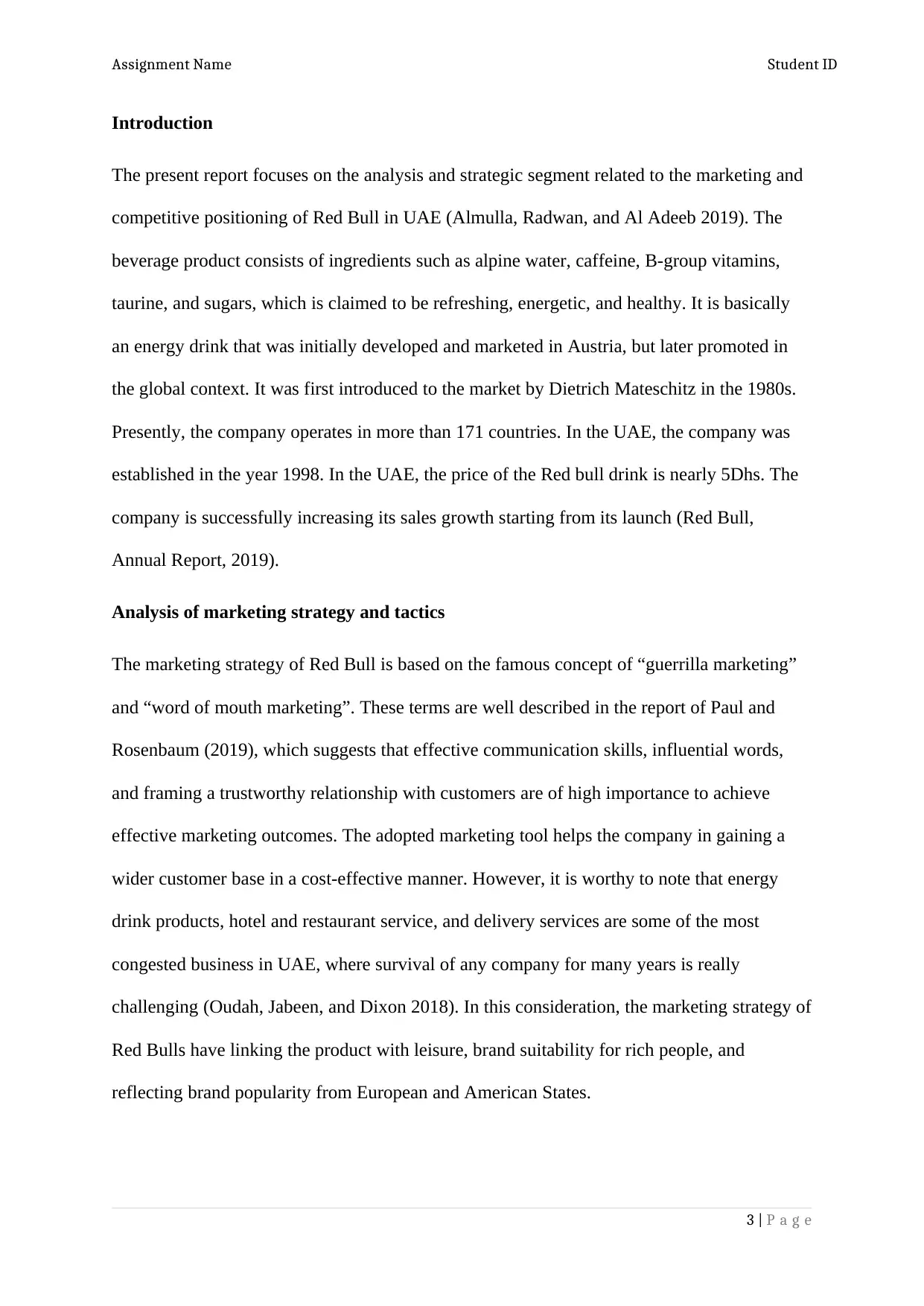
Assignment Name Student ID
Introduction
The present report focuses on the analysis and strategic segment related to the marketing and
competitive positioning of Red Bull in UAE (Almulla, Radwan, and Al Adeeb 2019). The
beverage product consists of ingredients such as alpine water, caffeine, B-group vitamins,
taurine, and sugars, which is claimed to be refreshing, energetic, and healthy. It is basically
an energy drink that was initially developed and marketed in Austria, but later promoted in
the global context. It was first introduced to the market by Dietrich Mateschitz in the 1980s.
Presently, the company operates in more than 171 countries. In the UAE, the company was
established in the year 1998. In the UAE, the price of the Red bull drink is nearly 5Dhs. The
company is successfully increasing its sales growth starting from its launch (Red Bull,
Annual Report, 2019).
Analysis of marketing strategy and tactics
The marketing strategy of Red Bull is based on the famous concept of “guerrilla marketing”
and “word of mouth marketing”. These terms are well described in the report of Paul and
Rosenbaum (2019), which suggests that effective communication skills, influential words,
and framing a trustworthy relationship with customers are of high importance to achieve
effective marketing outcomes. The adopted marketing tool helps the company in gaining a
wider customer base in a cost-effective manner. However, it is worthy to note that energy
drink products, hotel and restaurant service, and delivery services are some of the most
congested business in UAE, where survival of any company for many years is really
challenging (Oudah, Jabeen, and Dixon 2018). In this consideration, the marketing strategy of
Red Bulls have linking the product with leisure, brand suitability for rich people, and
reflecting brand popularity from European and American States.
3 | P a g e
Introduction
The present report focuses on the analysis and strategic segment related to the marketing and
competitive positioning of Red Bull in UAE (Almulla, Radwan, and Al Adeeb 2019). The
beverage product consists of ingredients such as alpine water, caffeine, B-group vitamins,
taurine, and sugars, which is claimed to be refreshing, energetic, and healthy. It is basically
an energy drink that was initially developed and marketed in Austria, but later promoted in
the global context. It was first introduced to the market by Dietrich Mateschitz in the 1980s.
Presently, the company operates in more than 171 countries. In the UAE, the company was
established in the year 1998. In the UAE, the price of the Red bull drink is nearly 5Dhs. The
company is successfully increasing its sales growth starting from its launch (Red Bull,
Annual Report, 2019).
Analysis of marketing strategy and tactics
The marketing strategy of Red Bull is based on the famous concept of “guerrilla marketing”
and “word of mouth marketing”. These terms are well described in the report of Paul and
Rosenbaum (2019), which suggests that effective communication skills, influential words,
and framing a trustworthy relationship with customers are of high importance to achieve
effective marketing outcomes. The adopted marketing tool helps the company in gaining a
wider customer base in a cost-effective manner. However, it is worthy to note that energy
drink products, hotel and restaurant service, and delivery services are some of the most
congested business in UAE, where survival of any company for many years is really
challenging (Oudah, Jabeen, and Dixon 2018). In this consideration, the marketing strategy of
Red Bulls have linking the product with leisure, brand suitability for rich people, and
reflecting brand popularity from European and American States.
3 | P a g e
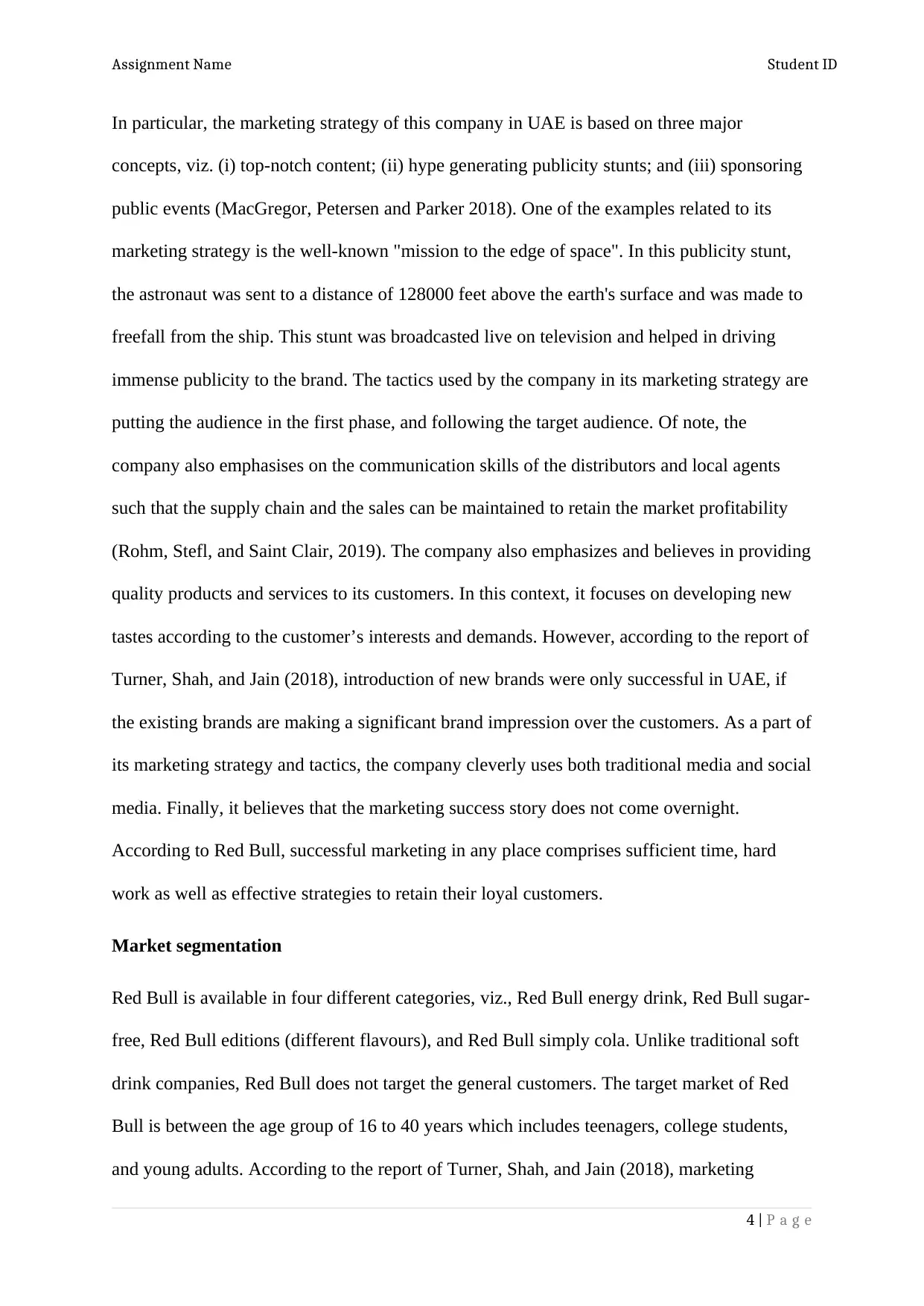
Assignment Name Student ID
In particular, the marketing strategy of this company in UAE is based on three major
concepts, viz. (i) top-notch content; (ii) hype generating publicity stunts; and (iii) sponsoring
public events (MacGregor, Petersen and Parker 2018). One of the examples related to its
marketing strategy is the well-known "mission to the edge of space". In this publicity stunt,
the astronaut was sent to a distance of 128000 feet above the earth's surface and was made to
freefall from the ship. This stunt was broadcasted live on television and helped in driving
immense publicity to the brand. The tactics used by the company in its marketing strategy are
putting the audience in the first phase, and following the target audience. Of note, the
company also emphasises on the communication skills of the distributors and local agents
such that the supply chain and the sales can be maintained to retain the market profitability
(Rohm, Stefl, and Saint Clair, 2019). The company also emphasizes and believes in providing
quality products and services to its customers. In this context, it focuses on developing new
tastes according to the customer’s interests and demands. However, according to the report of
Turner, Shah, and Jain (2018), introduction of new brands were only successful in UAE, if
the existing brands are making a significant brand impression over the customers. As a part of
its marketing strategy and tactics, the company cleverly uses both traditional media and social
media. Finally, it believes that the marketing success story does not come overnight.
According to Red Bull, successful marketing in any place comprises sufficient time, hard
work as well as effective strategies to retain their loyal customers.
Market segmentation
Red Bull is available in four different categories, viz., Red Bull energy drink, Red Bull sugar-
free, Red Bull editions (different flavours), and Red Bull simply cola. Unlike traditional soft
drink companies, Red Bull does not target the general customers. The target market of Red
Bull is between the age group of 16 to 40 years which includes teenagers, college students,
and young adults. According to the report of Turner, Shah, and Jain (2018), marketing
4 | P a g e
In particular, the marketing strategy of this company in UAE is based on three major
concepts, viz. (i) top-notch content; (ii) hype generating publicity stunts; and (iii) sponsoring
public events (MacGregor, Petersen and Parker 2018). One of the examples related to its
marketing strategy is the well-known "mission to the edge of space". In this publicity stunt,
the astronaut was sent to a distance of 128000 feet above the earth's surface and was made to
freefall from the ship. This stunt was broadcasted live on television and helped in driving
immense publicity to the brand. The tactics used by the company in its marketing strategy are
putting the audience in the first phase, and following the target audience. Of note, the
company also emphasises on the communication skills of the distributors and local agents
such that the supply chain and the sales can be maintained to retain the market profitability
(Rohm, Stefl, and Saint Clair, 2019). The company also emphasizes and believes in providing
quality products and services to its customers. In this context, it focuses on developing new
tastes according to the customer’s interests and demands. However, according to the report of
Turner, Shah, and Jain (2018), introduction of new brands were only successful in UAE, if
the existing brands are making a significant brand impression over the customers. As a part of
its marketing strategy and tactics, the company cleverly uses both traditional media and social
media. Finally, it believes that the marketing success story does not come overnight.
According to Red Bull, successful marketing in any place comprises sufficient time, hard
work as well as effective strategies to retain their loyal customers.
Market segmentation
Red Bull is available in four different categories, viz., Red Bull energy drink, Red Bull sugar-
free, Red Bull editions (different flavours), and Red Bull simply cola. Unlike traditional soft
drink companies, Red Bull does not target the general customers. The target market of Red
Bull is between the age group of 16 to 40 years which includes teenagers, college students,
and young adults. According to the report of Turner, Shah, and Jain (2018), marketing
4 | P a g e
Secure Best Marks with AI Grader
Need help grading? Try our AI Grader for instant feedback on your assignments.
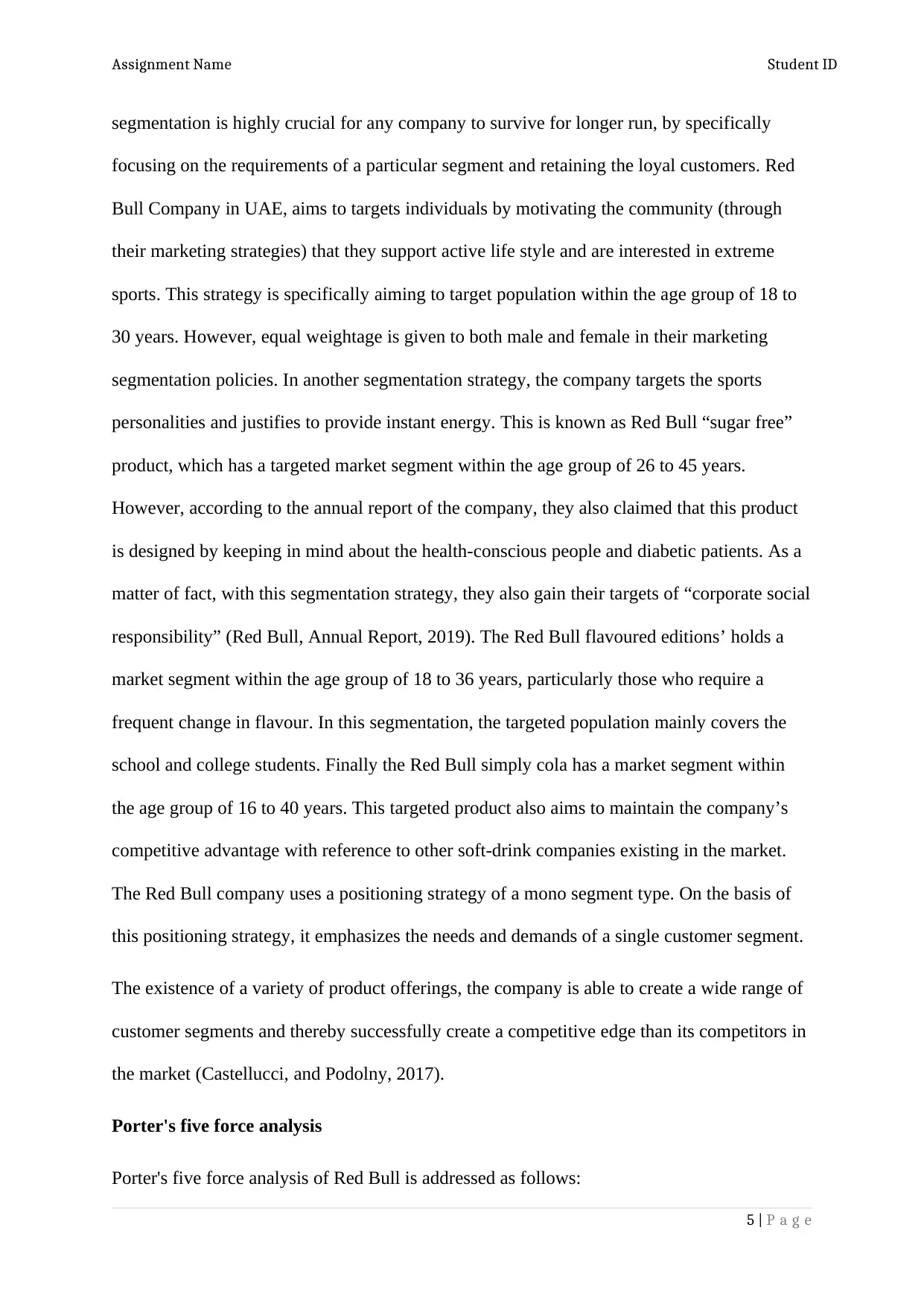
Assignment Name Student ID
segmentation is highly crucial for any company to survive for longer run, by specifically
focusing on the requirements of a particular segment and retaining the loyal customers. Red
Bull Company in UAE, aims to targets individuals by motivating the community (through
their marketing strategies) that they support active life style and are interested in extreme
sports. This strategy is specifically aiming to target population within the age group of 18 to
30 years. However, equal weightage is given to both male and female in their marketing
segmentation policies. In another segmentation strategy, the company targets the sports
personalities and justifies to provide instant energy. This is known as Red Bull “sugar free”
product, which has a targeted market segment within the age group of 26 to 45 years.
However, according to the annual report of the company, they also claimed that this product
is designed by keeping in mind about the health-conscious people and diabetic patients. As a
matter of fact, with this segmentation strategy, they also gain their targets of “corporate social
responsibility” (Red Bull, Annual Report, 2019). The Red Bull flavoured editions’ holds a
market segment within the age group of 18 to 36 years, particularly those who require a
frequent change in flavour. In this segmentation, the targeted population mainly covers the
school and college students. Finally the Red Bull simply cola has a market segment within
the age group of 16 to 40 years. This targeted product also aims to maintain the company’s
competitive advantage with reference to other soft-drink companies existing in the market.
The Red Bull company uses a positioning strategy of a mono segment type. On the basis of
this positioning strategy, it emphasizes the needs and demands of a single customer segment.
The existence of a variety of product offerings, the company is able to create a wide range of
customer segments and thereby successfully create a competitive edge than its competitors in
the market (Castellucci, and Podolny, 2017).
Porter's five force analysis
Porter's five force analysis of Red Bull is addressed as follows:
5 | P a g e
segmentation is highly crucial for any company to survive for longer run, by specifically
focusing on the requirements of a particular segment and retaining the loyal customers. Red
Bull Company in UAE, aims to targets individuals by motivating the community (through
their marketing strategies) that they support active life style and are interested in extreme
sports. This strategy is specifically aiming to target population within the age group of 18 to
30 years. However, equal weightage is given to both male and female in their marketing
segmentation policies. In another segmentation strategy, the company targets the sports
personalities and justifies to provide instant energy. This is known as Red Bull “sugar free”
product, which has a targeted market segment within the age group of 26 to 45 years.
However, according to the annual report of the company, they also claimed that this product
is designed by keeping in mind about the health-conscious people and diabetic patients. As a
matter of fact, with this segmentation strategy, they also gain their targets of “corporate social
responsibility” (Red Bull, Annual Report, 2019). The Red Bull flavoured editions’ holds a
market segment within the age group of 18 to 36 years, particularly those who require a
frequent change in flavour. In this segmentation, the targeted population mainly covers the
school and college students. Finally the Red Bull simply cola has a market segment within
the age group of 16 to 40 years. This targeted product also aims to maintain the company’s
competitive advantage with reference to other soft-drink companies existing in the market.
The Red Bull company uses a positioning strategy of a mono segment type. On the basis of
this positioning strategy, it emphasizes the needs and demands of a single customer segment.
The existence of a variety of product offerings, the company is able to create a wide range of
customer segments and thereby successfully create a competitive edge than its competitors in
the market (Castellucci, and Podolny, 2017).
Porter's five force analysis
Porter's five force analysis of Red Bull is addressed as follows:
5 | P a g e
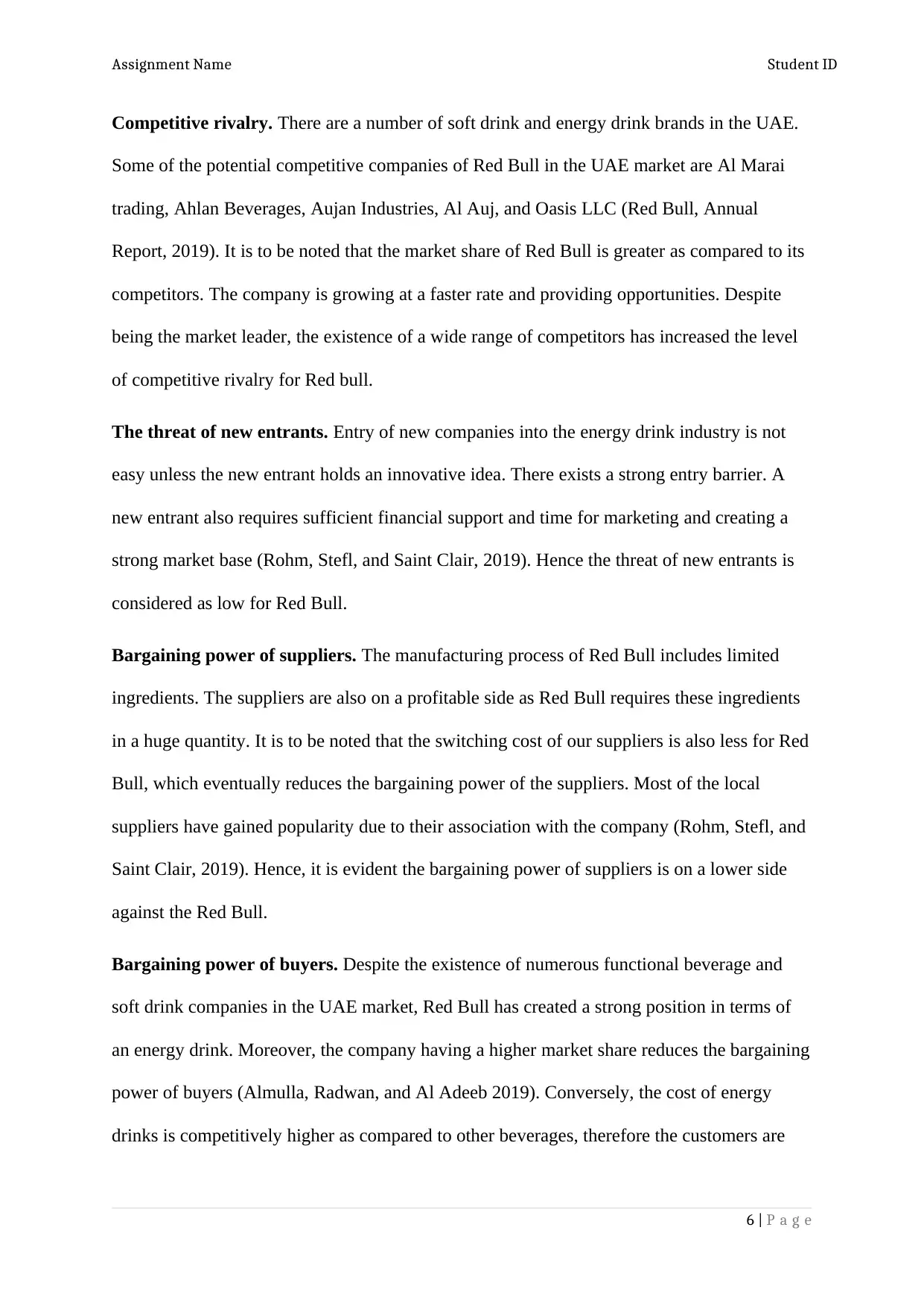
Assignment Name Student ID
Competitive rivalry. There are a number of soft drink and energy drink brands in the UAE.
Some of the potential competitive companies of Red Bull in the UAE market are Al Marai
trading, Ahlan Beverages, Aujan Industries, Al Auj, and Oasis LLC (Red Bull, Annual
Report, 2019). It is to be noted that the market share of Red Bull is greater as compared to its
competitors. The company is growing at a faster rate and providing opportunities. Despite
being the market leader, the existence of a wide range of competitors has increased the level
of competitive rivalry for Red bull.
The threat of new entrants. Entry of new companies into the energy drink industry is not
easy unless the new entrant holds an innovative idea. There exists a strong entry barrier. A
new entrant also requires sufficient financial support and time for marketing and creating a
strong market base (Rohm, Stefl, and Saint Clair, 2019). Hence the threat of new entrants is
considered as low for Red Bull.
Bargaining power of suppliers. The manufacturing process of Red Bull includes limited
ingredients. The suppliers are also on a profitable side as Red Bull requires these ingredients
in a huge quantity. It is to be noted that the switching cost of our suppliers is also less for Red
Bull, which eventually reduces the bargaining power of the suppliers. Most of the local
suppliers have gained popularity due to their association with the company (Rohm, Stefl, and
Saint Clair, 2019). Hence, it is evident the bargaining power of suppliers is on a lower side
against the Red Bull.
Bargaining power of buyers. Despite the existence of numerous functional beverage and
soft drink companies in the UAE market, Red Bull has created a strong position in terms of
an energy drink. Moreover, the company having a higher market share reduces the bargaining
power of buyers (Almulla, Radwan, and Al Adeeb 2019). Conversely, the cost of energy
drinks is competitively higher as compared to other beverages, therefore the customers are
6 | P a g e
Competitive rivalry. There are a number of soft drink and energy drink brands in the UAE.
Some of the potential competitive companies of Red Bull in the UAE market are Al Marai
trading, Ahlan Beverages, Aujan Industries, Al Auj, and Oasis LLC (Red Bull, Annual
Report, 2019). It is to be noted that the market share of Red Bull is greater as compared to its
competitors. The company is growing at a faster rate and providing opportunities. Despite
being the market leader, the existence of a wide range of competitors has increased the level
of competitive rivalry for Red bull.
The threat of new entrants. Entry of new companies into the energy drink industry is not
easy unless the new entrant holds an innovative idea. There exists a strong entry barrier. A
new entrant also requires sufficient financial support and time for marketing and creating a
strong market base (Rohm, Stefl, and Saint Clair, 2019). Hence the threat of new entrants is
considered as low for Red Bull.
Bargaining power of suppliers. The manufacturing process of Red Bull includes limited
ingredients. The suppliers are also on a profitable side as Red Bull requires these ingredients
in a huge quantity. It is to be noted that the switching cost of our suppliers is also less for Red
Bull, which eventually reduces the bargaining power of the suppliers. Most of the local
suppliers have gained popularity due to their association with the company (Rohm, Stefl, and
Saint Clair, 2019). Hence, it is evident the bargaining power of suppliers is on a lower side
against the Red Bull.
Bargaining power of buyers. Despite the existence of numerous functional beverage and
soft drink companies in the UAE market, Red Bull has created a strong position in terms of
an energy drink. Moreover, the company having a higher market share reduces the bargaining
power of buyers (Almulla, Radwan, and Al Adeeb 2019). Conversely, the cost of energy
drinks is competitively higher as compared to other beverages, therefore the customers are
6 | P a g e
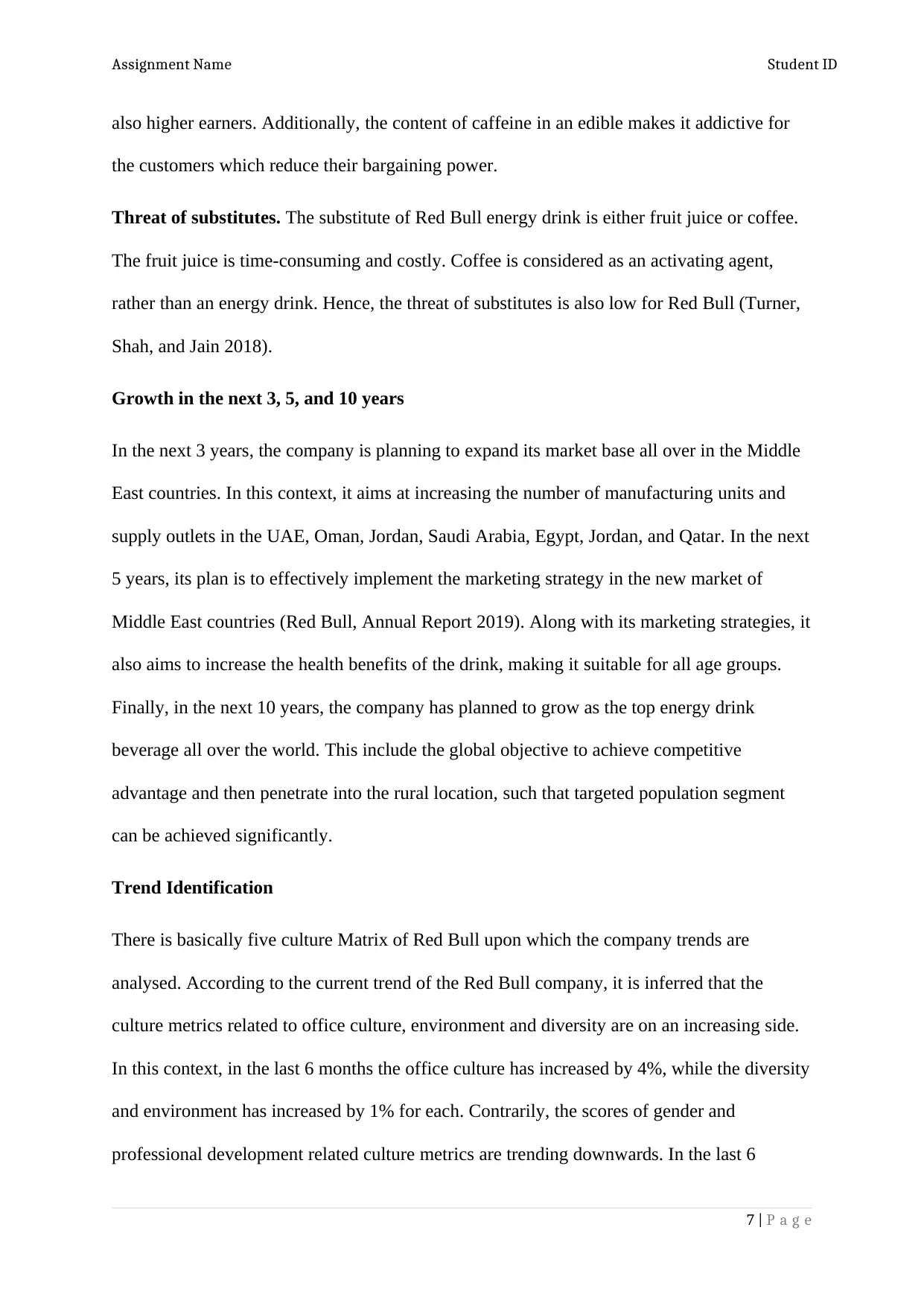
Assignment Name Student ID
also higher earners. Additionally, the content of caffeine in an edible makes it addictive for
the customers which reduce their bargaining power.
Threat of substitutes. The substitute of Red Bull energy drink is either fruit juice or coffee.
The fruit juice is time-consuming and costly. Coffee is considered as an activating agent,
rather than an energy drink. Hence, the threat of substitutes is also low for Red Bull (Turner,
Shah, and Jain 2018).
Growth in the next 3, 5, and 10 years
In the next 3 years, the company is planning to expand its market base all over in the Middle
East countries. In this context, it aims at increasing the number of manufacturing units and
supply outlets in the UAE, Oman, Jordan, Saudi Arabia, Egypt, Jordan, and Qatar. In the next
5 years, its plan is to effectively implement the marketing strategy in the new market of
Middle East countries (Red Bull, Annual Report 2019). Along with its marketing strategies, it
also aims to increase the health benefits of the drink, making it suitable for all age groups.
Finally, in the next 10 years, the company has planned to grow as the top energy drink
beverage all over the world. This include the global objective to achieve competitive
advantage and then penetrate into the rural location, such that targeted population segment
can be achieved significantly.
Trend Identification
There is basically five culture Matrix of Red Bull upon which the company trends are
analysed. According to the current trend of the Red Bull company, it is inferred that the
culture metrics related to office culture, environment and diversity are on an increasing side.
In this context, in the last 6 months the office culture has increased by 4%, while the diversity
and environment has increased by 1% for each. Contrarily, the scores of gender and
professional development related culture metrics are trending downwards. In the last 6
7 | P a g e
also higher earners. Additionally, the content of caffeine in an edible makes it addictive for
the customers which reduce their bargaining power.
Threat of substitutes. The substitute of Red Bull energy drink is either fruit juice or coffee.
The fruit juice is time-consuming and costly. Coffee is considered as an activating agent,
rather than an energy drink. Hence, the threat of substitutes is also low for Red Bull (Turner,
Shah, and Jain 2018).
Growth in the next 3, 5, and 10 years
In the next 3 years, the company is planning to expand its market base all over in the Middle
East countries. In this context, it aims at increasing the number of manufacturing units and
supply outlets in the UAE, Oman, Jordan, Saudi Arabia, Egypt, Jordan, and Qatar. In the next
5 years, its plan is to effectively implement the marketing strategy in the new market of
Middle East countries (Red Bull, Annual Report 2019). Along with its marketing strategies, it
also aims to increase the health benefits of the drink, making it suitable for all age groups.
Finally, in the next 10 years, the company has planned to grow as the top energy drink
beverage all over the world. This include the global objective to achieve competitive
advantage and then penetrate into the rural location, such that targeted population segment
can be achieved significantly.
Trend Identification
There is basically five culture Matrix of Red Bull upon which the company trends are
analysed. According to the current trend of the Red Bull company, it is inferred that the
culture metrics related to office culture, environment and diversity are on an increasing side.
In this context, in the last 6 months the office culture has increased by 4%, while the diversity
and environment has increased by 1% for each. Contrarily, the scores of gender and
professional development related culture metrics are trending downwards. In the last 6
7 | P a g e
Paraphrase This Document
Need a fresh take? Get an instant paraphrase of this document with our AI Paraphraser
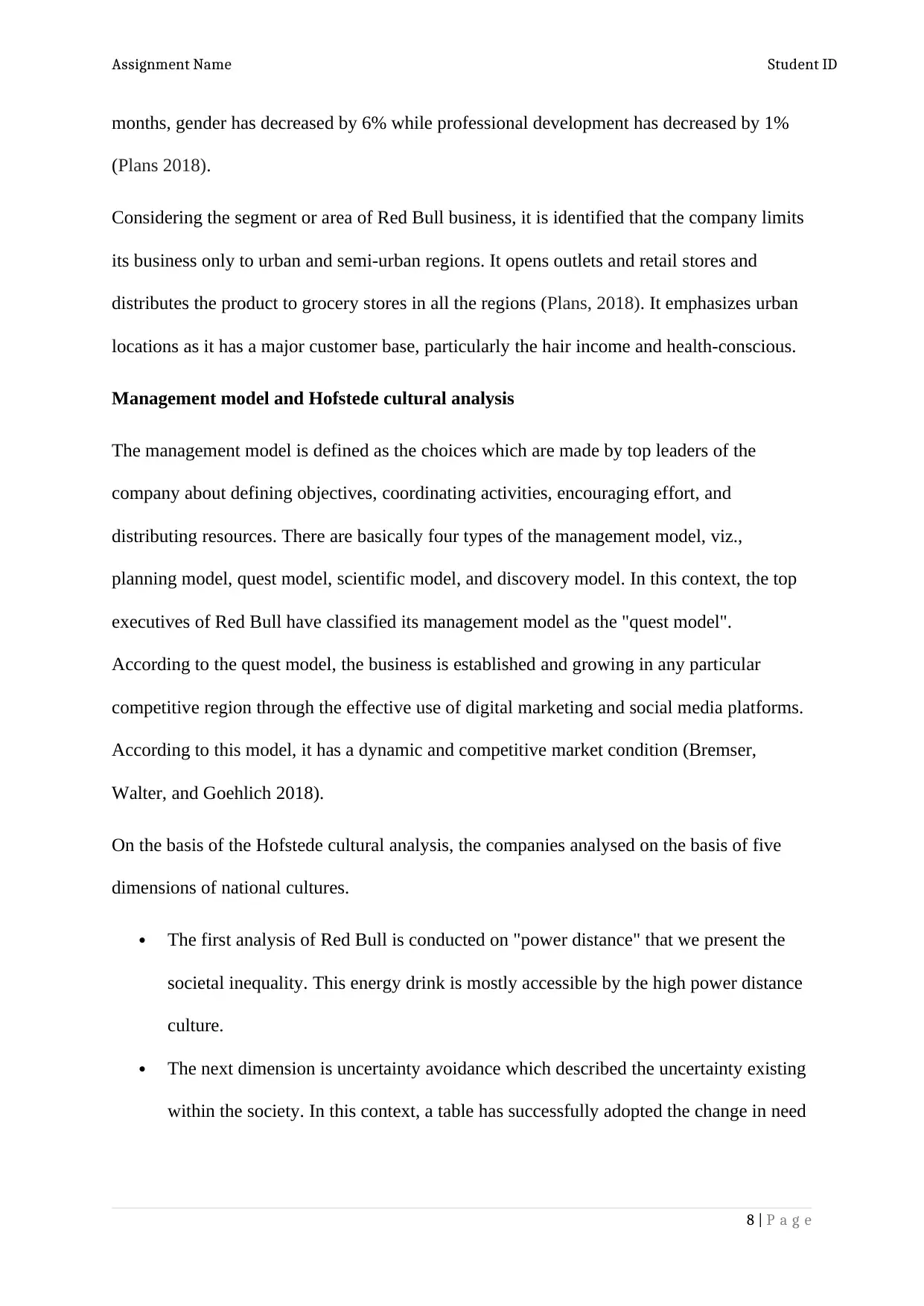
Assignment Name Student ID
months, gender has decreased by 6% while professional development has decreased by 1%
(Plans 2018).
Considering the segment or area of Red Bull business, it is identified that the company limits
its business only to urban and semi-urban regions. It opens outlets and retail stores and
distributes the product to grocery stores in all the regions (Plans, 2018). It emphasizes urban
locations as it has a major customer base, particularly the hair income and health-conscious.
Management model and Hofstede cultural analysis
The management model is defined as the choices which are made by top leaders of the
company about defining objectives, coordinating activities, encouraging effort, and
distributing resources. There are basically four types of the management model, viz.,
planning model, quest model, scientific model, and discovery model. In this context, the top
executives of Red Bull have classified its management model as the "quest model".
According to the quest model, the business is established and growing in any particular
competitive region through the effective use of digital marketing and social media platforms.
According to this model, it has a dynamic and competitive market condition (Bremser,
Walter, and Goehlich 2018).
On the basis of the Hofstede cultural analysis, the companies analysed on the basis of five
dimensions of national cultures.
The first analysis of Red Bull is conducted on "power distance" that we present the
societal inequality. This energy drink is mostly accessible by the high power distance
culture.
The next dimension is uncertainty avoidance which described the uncertainty existing
within the society. In this context, a table has successfully adopted the change in need
8 | P a g e
months, gender has decreased by 6% while professional development has decreased by 1%
(Plans 2018).
Considering the segment or area of Red Bull business, it is identified that the company limits
its business only to urban and semi-urban regions. It opens outlets and retail stores and
distributes the product to grocery stores in all the regions (Plans, 2018). It emphasizes urban
locations as it has a major customer base, particularly the hair income and health-conscious.
Management model and Hofstede cultural analysis
The management model is defined as the choices which are made by top leaders of the
company about defining objectives, coordinating activities, encouraging effort, and
distributing resources. There are basically four types of the management model, viz.,
planning model, quest model, scientific model, and discovery model. In this context, the top
executives of Red Bull have classified its management model as the "quest model".
According to the quest model, the business is established and growing in any particular
competitive region through the effective use of digital marketing and social media platforms.
According to this model, it has a dynamic and competitive market condition (Bremser,
Walter, and Goehlich 2018).
On the basis of the Hofstede cultural analysis, the companies analysed on the basis of five
dimensions of national cultures.
The first analysis of Red Bull is conducted on "power distance" that we present the
societal inequality. This energy drink is mostly accessible by the high power distance
culture.
The next dimension is uncertainty avoidance which described the uncertainty existing
within the society. In this context, a table has successfully adopted the change in need
8 | P a g e
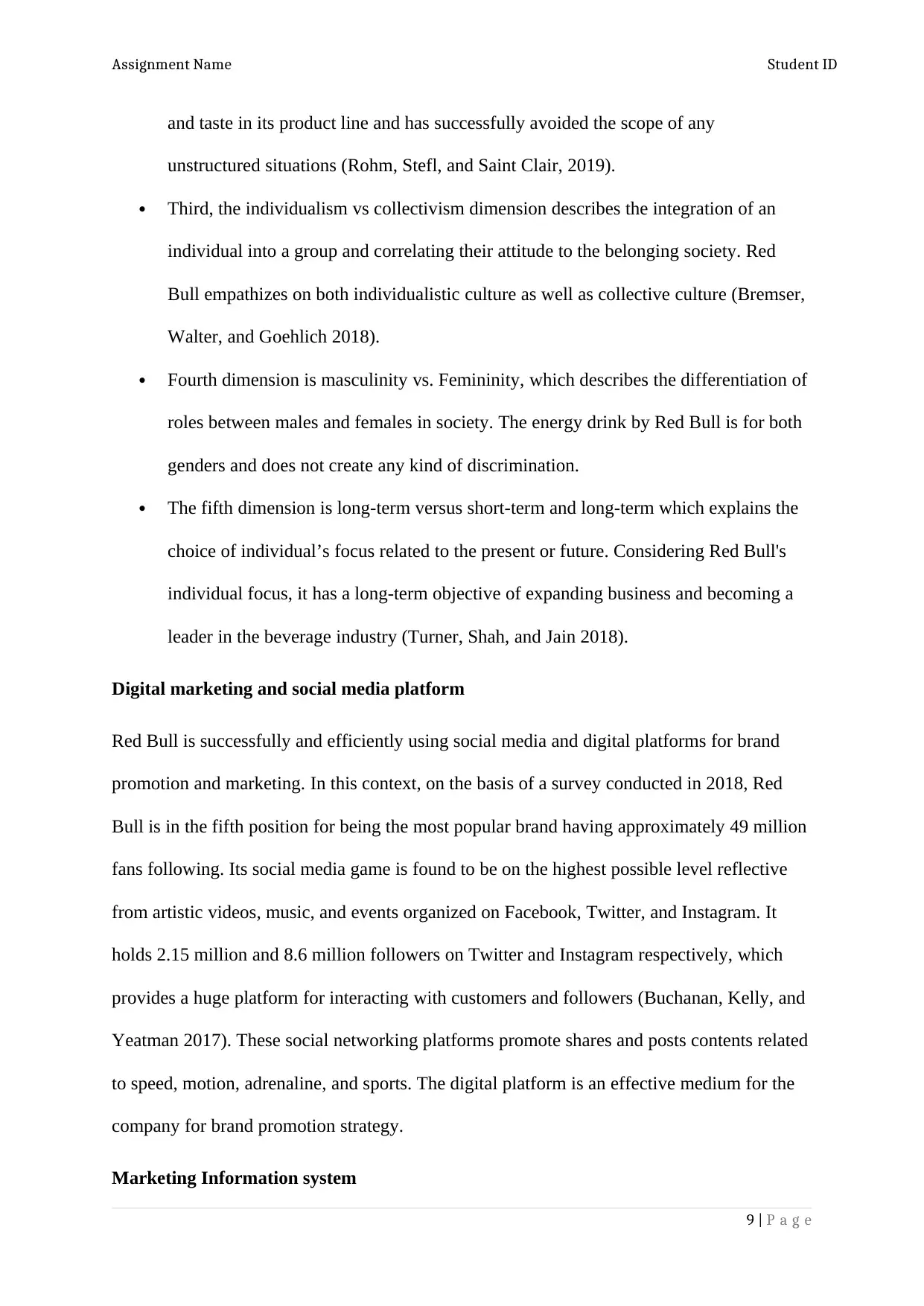
Assignment Name Student ID
and taste in its product line and has successfully avoided the scope of any
unstructured situations (Rohm, Stefl, and Saint Clair, 2019).
Third, the individualism vs collectivism dimension describes the integration of an
individual into a group and correlating their attitude to the belonging society. Red
Bull empathizes on both individualistic culture as well as collective culture (Bremser,
Walter, and Goehlich 2018).
Fourth dimension is masculinity vs. Femininity, which describes the differentiation of
roles between males and females in society. The energy drink by Red Bull is for both
genders and does not create any kind of discrimination.
The fifth dimension is long-term versus short-term and long-term which explains the
choice of individual’s focus related to the present or future. Considering Red Bull's
individual focus, it has a long-term objective of expanding business and becoming a
leader in the beverage industry (Turner, Shah, and Jain 2018).
Digital marketing and social media platform
Red Bull is successfully and efficiently using social media and digital platforms for brand
promotion and marketing. In this context, on the basis of a survey conducted in 2018, Red
Bull is in the fifth position for being the most popular brand having approximately 49 million
fans following. Its social media game is found to be on the highest possible level reflective
from artistic videos, music, and events organized on Facebook, Twitter, and Instagram. It
holds 2.15 million and 8.6 million followers on Twitter and Instagram respectively, which
provides a huge platform for interacting with customers and followers (Buchanan, Kelly, and
Yeatman 2017). These social networking platforms promote shares and posts contents related
to speed, motion, adrenaline, and sports. The digital platform is an effective medium for the
company for brand promotion strategy.
Marketing Information system
9 | P a g e
and taste in its product line and has successfully avoided the scope of any
unstructured situations (Rohm, Stefl, and Saint Clair, 2019).
Third, the individualism vs collectivism dimension describes the integration of an
individual into a group and correlating their attitude to the belonging society. Red
Bull empathizes on both individualistic culture as well as collective culture (Bremser,
Walter, and Goehlich 2018).
Fourth dimension is masculinity vs. Femininity, which describes the differentiation of
roles between males and females in society. The energy drink by Red Bull is for both
genders and does not create any kind of discrimination.
The fifth dimension is long-term versus short-term and long-term which explains the
choice of individual’s focus related to the present or future. Considering Red Bull's
individual focus, it has a long-term objective of expanding business and becoming a
leader in the beverage industry (Turner, Shah, and Jain 2018).
Digital marketing and social media platform
Red Bull is successfully and efficiently using social media and digital platforms for brand
promotion and marketing. In this context, on the basis of a survey conducted in 2018, Red
Bull is in the fifth position for being the most popular brand having approximately 49 million
fans following. Its social media game is found to be on the highest possible level reflective
from artistic videos, music, and events organized on Facebook, Twitter, and Instagram. It
holds 2.15 million and 8.6 million followers on Twitter and Instagram respectively, which
provides a huge platform for interacting with customers and followers (Buchanan, Kelly, and
Yeatman 2017). These social networking platforms promote shares and posts contents related
to speed, motion, adrenaline, and sports. The digital platform is an effective medium for the
company for brand promotion strategy.
Marketing Information system
9 | P a g e
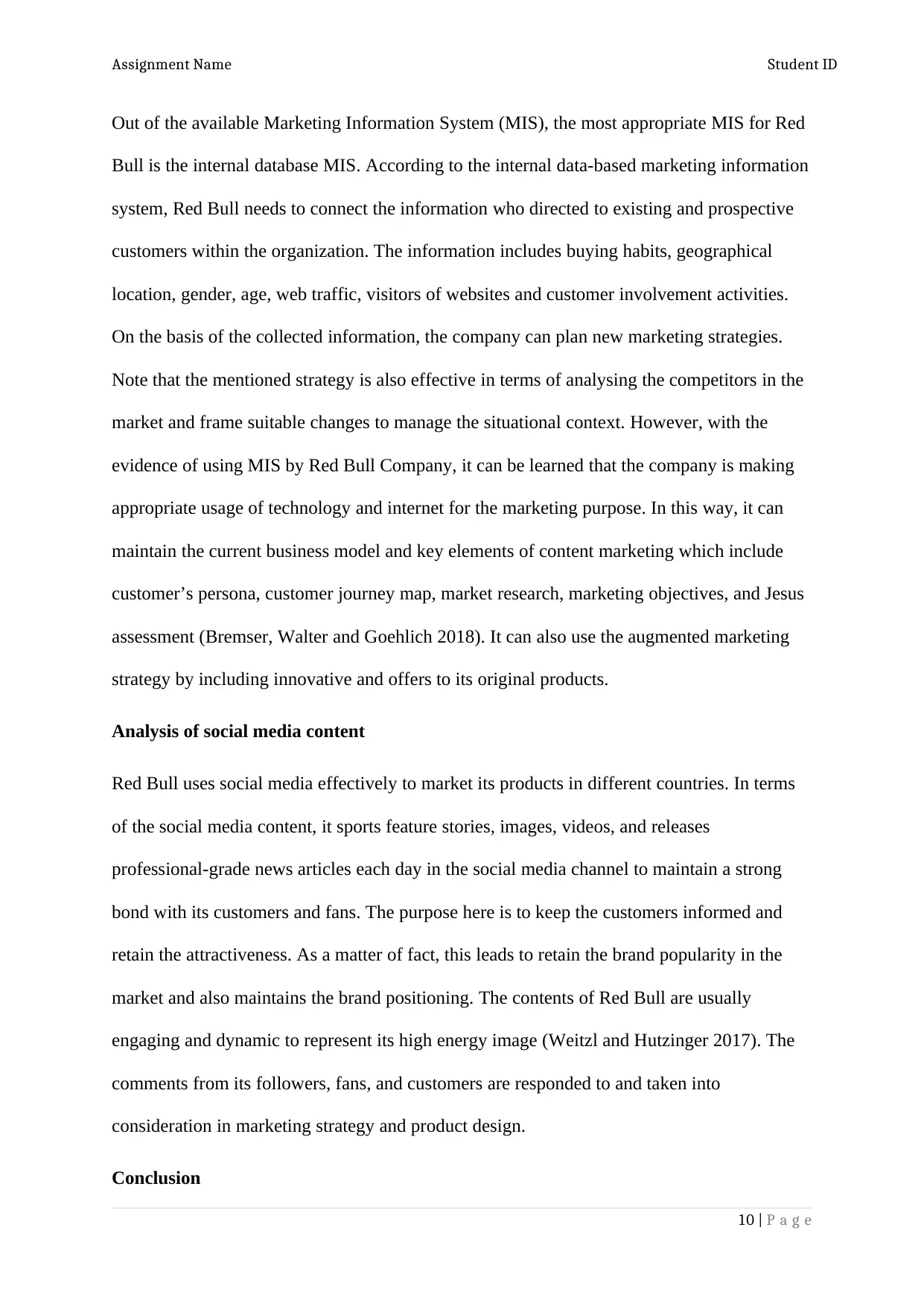
Assignment Name Student ID
Out of the available Marketing Information System (MIS), the most appropriate MIS for Red
Bull is the internal database MIS. According to the internal data-based marketing information
system, Red Bull needs to connect the information who directed to existing and prospective
customers within the organization. The information includes buying habits, geographical
location, gender, age, web traffic, visitors of websites and customer involvement activities.
On the basis of the collected information, the company can plan new marketing strategies.
Note that the mentioned strategy is also effective in terms of analysing the competitors in the
market and frame suitable changes to manage the situational context. However, with the
evidence of using MIS by Red Bull Company, it can be learned that the company is making
appropriate usage of technology and internet for the marketing purpose. In this way, it can
maintain the current business model and key elements of content marketing which include
customer’s persona, customer journey map, market research, marketing objectives, and Jesus
assessment (Bremser, Walter and Goehlich 2018). It can also use the augmented marketing
strategy by including innovative and offers to its original products.
Analysis of social media content
Red Bull uses social media effectively to market its products in different countries. In terms
of the social media content, it sports feature stories, images, videos, and releases
professional-grade news articles each day in the social media channel to maintain a strong
bond with its customers and fans. The purpose here is to keep the customers informed and
retain the attractiveness. As a matter of fact, this leads to retain the brand popularity in the
market and also maintains the brand positioning. The contents of Red Bull are usually
engaging and dynamic to represent its high energy image (Weitzl and Hutzinger 2017). The
comments from its followers, fans, and customers are responded to and taken into
consideration in marketing strategy and product design.
Conclusion
10 | P a g e
Out of the available Marketing Information System (MIS), the most appropriate MIS for Red
Bull is the internal database MIS. According to the internal data-based marketing information
system, Red Bull needs to connect the information who directed to existing and prospective
customers within the organization. The information includes buying habits, geographical
location, gender, age, web traffic, visitors of websites and customer involvement activities.
On the basis of the collected information, the company can plan new marketing strategies.
Note that the mentioned strategy is also effective in terms of analysing the competitors in the
market and frame suitable changes to manage the situational context. However, with the
evidence of using MIS by Red Bull Company, it can be learned that the company is making
appropriate usage of technology and internet for the marketing purpose. In this way, it can
maintain the current business model and key elements of content marketing which include
customer’s persona, customer journey map, market research, marketing objectives, and Jesus
assessment (Bremser, Walter and Goehlich 2018). It can also use the augmented marketing
strategy by including innovative and offers to its original products.
Analysis of social media content
Red Bull uses social media effectively to market its products in different countries. In terms
of the social media content, it sports feature stories, images, videos, and releases
professional-grade news articles each day in the social media channel to maintain a strong
bond with its customers and fans. The purpose here is to keep the customers informed and
retain the attractiveness. As a matter of fact, this leads to retain the brand popularity in the
market and also maintains the brand positioning. The contents of Red Bull are usually
engaging and dynamic to represent its high energy image (Weitzl and Hutzinger 2017). The
comments from its followers, fans, and customers are responded to and taken into
consideration in marketing strategy and product design.
Conclusion
10 | P a g e
Secure Best Marks with AI Grader
Need help grading? Try our AI Grader for instant feedback on your assignments.
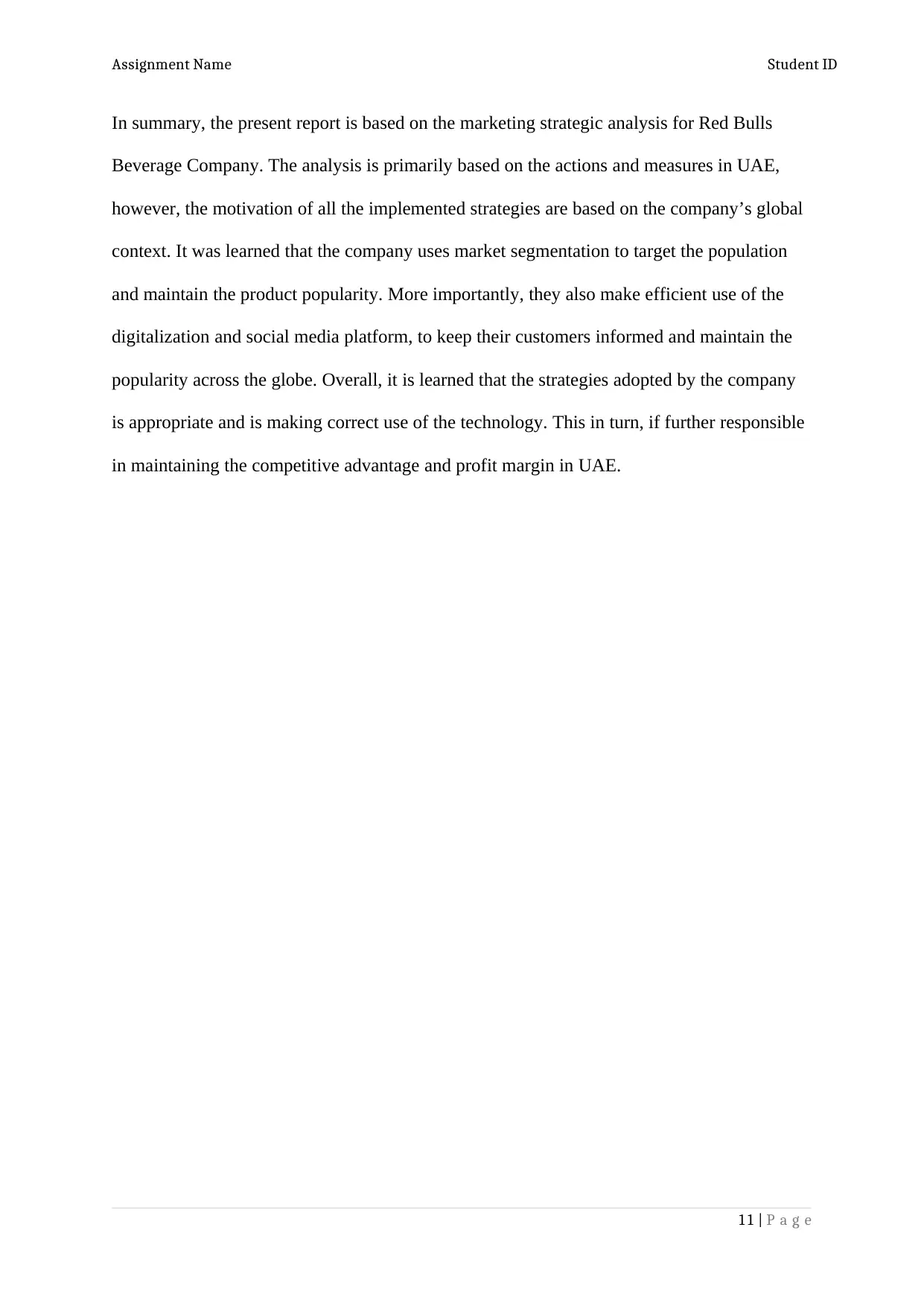
Assignment Name Student ID
In summary, the present report is based on the marketing strategic analysis for Red Bulls
Beverage Company. The analysis is primarily based on the actions and measures in UAE,
however, the motivation of all the implemented strategies are based on the company’s global
context. It was learned that the company uses market segmentation to target the population
and maintain the product popularity. More importantly, they also make efficient use of the
digitalization and social media platform, to keep their customers informed and maintain the
popularity across the globe. Overall, it is learned that the strategies adopted by the company
is appropriate and is making correct use of the technology. This in turn, if further responsible
in maintaining the competitive advantage and profit margin in UAE.
11 | P a g e
In summary, the present report is based on the marketing strategic analysis for Red Bulls
Beverage Company. The analysis is primarily based on the actions and measures in UAE,
however, the motivation of all the implemented strategies are based on the company’s global
context. It was learned that the company uses market segmentation to target the population
and maintain the product popularity. More importantly, they also make efficient use of the
digitalization and social media platform, to keep their customers informed and maintain the
popularity across the globe. Overall, it is learned that the strategies adopted by the company
is appropriate and is making correct use of the technology. This in turn, if further responsible
in maintaining the competitive advantage and profit margin in UAE.
11 | P a g e
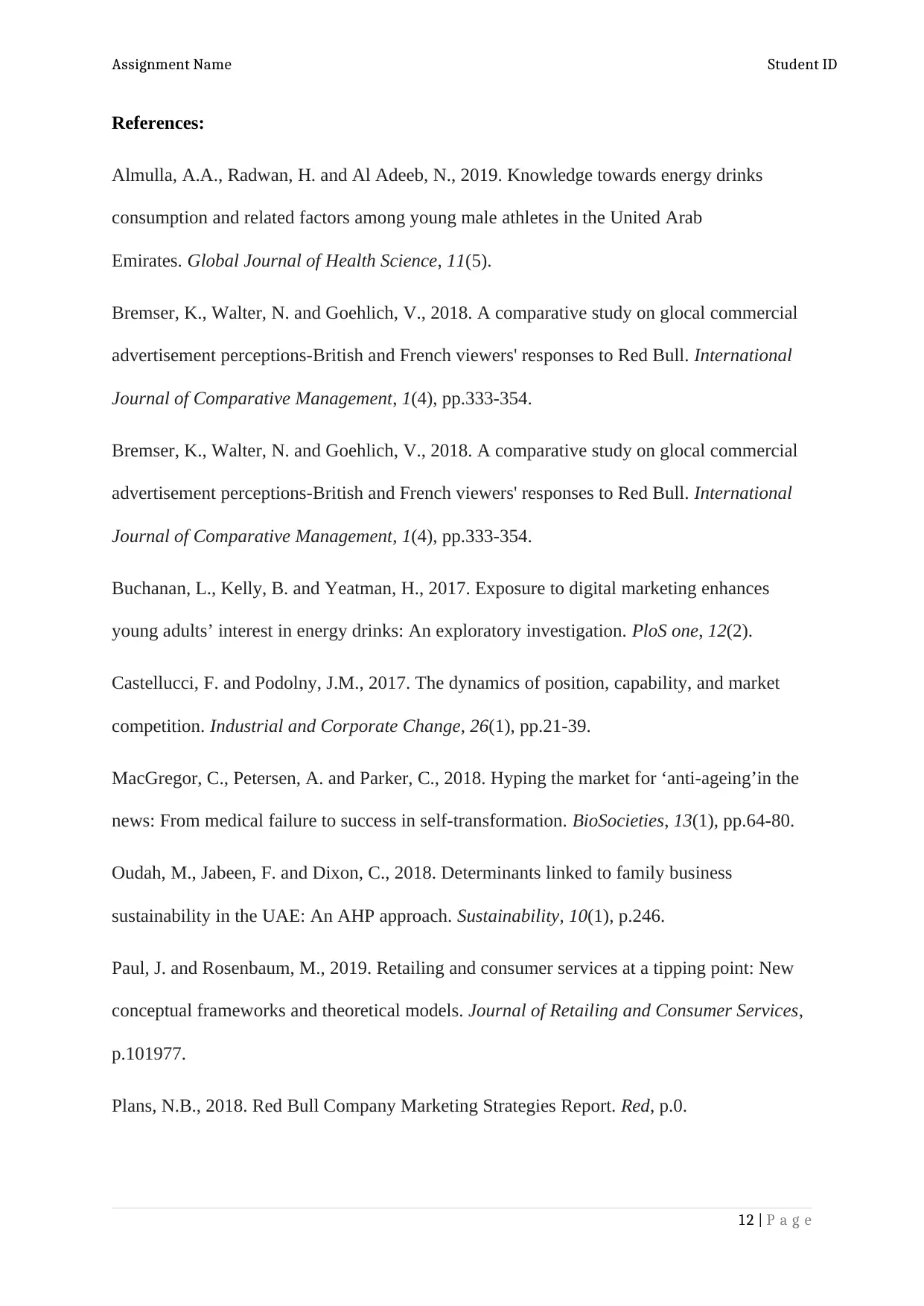
Assignment Name Student ID
References:
Almulla, A.A., Radwan, H. and Al Adeeb, N., 2019. Knowledge towards energy drinks
consumption and related factors among young male athletes in the United Arab
Emirates. Global Journal of Health Science, 11(5).
Bremser, K., Walter, N. and Goehlich, V., 2018. A comparative study on glocal commercial
advertisement perceptions-British and French viewers' responses to Red Bull. International
Journal of Comparative Management, 1(4), pp.333-354.
Bremser, K., Walter, N. and Goehlich, V., 2018. A comparative study on glocal commercial
advertisement perceptions-British and French viewers' responses to Red Bull. International
Journal of Comparative Management, 1(4), pp.333-354.
Buchanan, L., Kelly, B. and Yeatman, H., 2017. Exposure to digital marketing enhances
young adults’ interest in energy drinks: An exploratory investigation. PloS one, 12(2).
Castellucci, F. and Podolny, J.M., 2017. The dynamics of position, capability, and market
competition. Industrial and Corporate Change, 26(1), pp.21-39.
MacGregor, C., Petersen, A. and Parker, C., 2018. Hyping the market for ‘anti-ageing’in the
news: From medical failure to success in self-transformation. BioSocieties, 13(1), pp.64-80.
Oudah, M., Jabeen, F. and Dixon, C., 2018. Determinants linked to family business
sustainability in the UAE: An AHP approach. Sustainability, 10(1), p.246.
Paul, J. and Rosenbaum, M., 2019. Retailing and consumer services at a tipping point: New
conceptual frameworks and theoretical models. Journal of Retailing and Consumer Services,
p.101977.
Plans, N.B., 2018. Red Bull Company Marketing Strategies Report. Red, p.0.
12 | P a g e
References:
Almulla, A.A., Radwan, H. and Al Adeeb, N., 2019. Knowledge towards energy drinks
consumption and related factors among young male athletes in the United Arab
Emirates. Global Journal of Health Science, 11(5).
Bremser, K., Walter, N. and Goehlich, V., 2018. A comparative study on glocal commercial
advertisement perceptions-British and French viewers' responses to Red Bull. International
Journal of Comparative Management, 1(4), pp.333-354.
Bremser, K., Walter, N. and Goehlich, V., 2018. A comparative study on glocal commercial
advertisement perceptions-British and French viewers' responses to Red Bull. International
Journal of Comparative Management, 1(4), pp.333-354.
Buchanan, L., Kelly, B. and Yeatman, H., 2017. Exposure to digital marketing enhances
young adults’ interest in energy drinks: An exploratory investigation. PloS one, 12(2).
Castellucci, F. and Podolny, J.M., 2017. The dynamics of position, capability, and market
competition. Industrial and Corporate Change, 26(1), pp.21-39.
MacGregor, C., Petersen, A. and Parker, C., 2018. Hyping the market for ‘anti-ageing’in the
news: From medical failure to success in self-transformation. BioSocieties, 13(1), pp.64-80.
Oudah, M., Jabeen, F. and Dixon, C., 2018. Determinants linked to family business
sustainability in the UAE: An AHP approach. Sustainability, 10(1), p.246.
Paul, J. and Rosenbaum, M., 2019. Retailing and consumer services at a tipping point: New
conceptual frameworks and theoretical models. Journal of Retailing and Consumer Services,
p.101977.
Plans, N.B., 2018. Red Bull Company Marketing Strategies Report. Red, p.0.
12 | P a g e
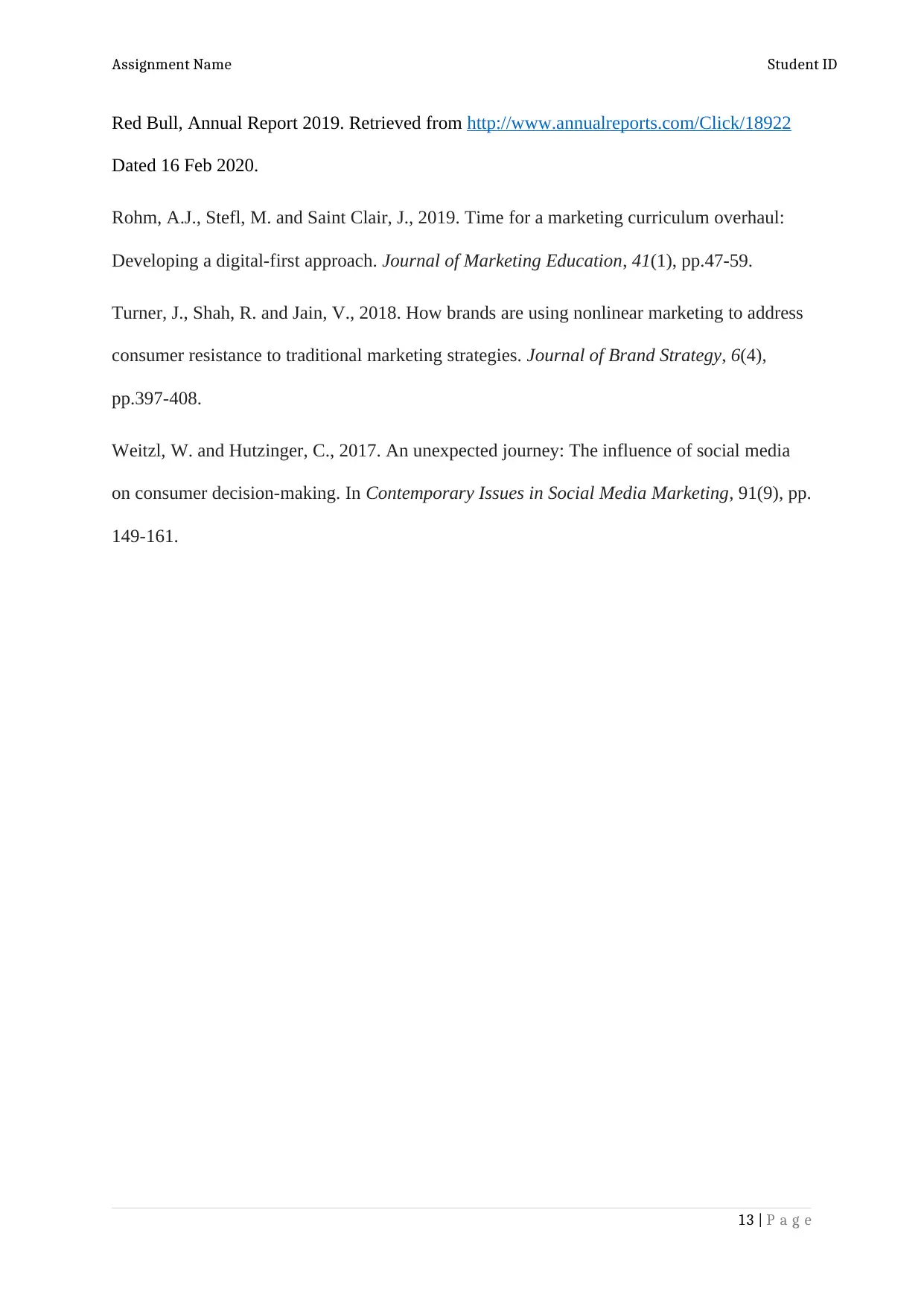
Assignment Name Student ID
Red Bull, Annual Report 2019. Retrieved from http://www.annualreports.com/Click/18922
Dated 16 Feb 2020.
Rohm, A.J., Stefl, M. and Saint Clair, J., 2019. Time for a marketing curriculum overhaul:
Developing a digital-first approach. Journal of Marketing Education, 41(1), pp.47-59.
Turner, J., Shah, R. and Jain, V., 2018. How brands are using nonlinear marketing to address
consumer resistance to traditional marketing strategies. Journal of Brand Strategy, 6(4),
pp.397-408.
Weitzl, W. and Hutzinger, C., 2017. An unexpected journey: The influence of social media
on consumer decision-making. In Contemporary Issues in Social Media Marketing, 91(9), pp.
149-161.
13 | P a g e
Red Bull, Annual Report 2019. Retrieved from http://www.annualreports.com/Click/18922
Dated 16 Feb 2020.
Rohm, A.J., Stefl, M. and Saint Clair, J., 2019. Time for a marketing curriculum overhaul:
Developing a digital-first approach. Journal of Marketing Education, 41(1), pp.47-59.
Turner, J., Shah, R. and Jain, V., 2018. How brands are using nonlinear marketing to address
consumer resistance to traditional marketing strategies. Journal of Brand Strategy, 6(4),
pp.397-408.
Weitzl, W. and Hutzinger, C., 2017. An unexpected journey: The influence of social media
on consumer decision-making. In Contemporary Issues in Social Media Marketing, 91(9), pp.
149-161.
13 | P a g e
1 out of 13
Related Documents
Your All-in-One AI-Powered Toolkit for Academic Success.
+13062052269
info@desklib.com
Available 24*7 on WhatsApp / Email
![[object Object]](/_next/static/media/star-bottom.7253800d.svg)
Unlock your academic potential
© 2024 | Zucol Services PVT LTD | All rights reserved.




